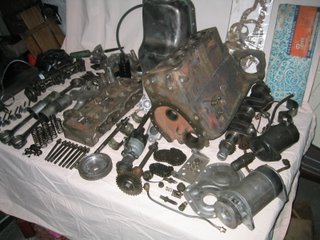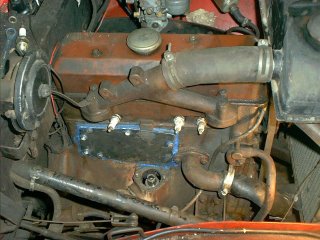With the arrival of the "powerless" Super Ten, I turned to the 9 HP engine that I was rebuilding for my 48 Roadster. The Roadster arrived with a 10 HP engine and gearbox installed. That combination suited me just fine once the necessary mods to the propeller shaft and gearbox mount were made.
I recently found a '51 4A engine and gearbox. The engine was almost completely dismantled, but upon first inspection seemed to be in very good shape. The rest of the block was stripped of parts and was sent, along with the head, to be skimmed.
 One important step in the disassembly of an engine, or other assembly, is to be sure that the removed parts are catalogued for future inspection, cleaning, restoration and or reinstallation. A digital camera is very helpful in recording which end is up and and which is down. Many bits look similar, or seem symmetrical, but are not. Nuts and bolts can also be of different grades or strengths. This is especially true of the nuts for the head, or the bearing caps.
One important step in the disassembly of an engine, or other assembly, is to be sure that the removed parts are catalogued for future inspection, cleaning, restoration and or reinstallation. A digital camera is very helpful in recording which end is up and and which is down. Many bits look similar, or seem symmetrical, but are not. Nuts and bolts can also be of different grades or strengths. This is especially true of the nuts for the head, or the bearing caps.
With the engine stripped of grime and paint, we can inspect for potential problems. One dangerous shortfall of these 9 & 10 HP bloc ks is the chances of the block cracking should the coolant freeze. This usually occurs on the right side of the engine near the distributor. Take a plastic water bottle, fill it to the top with water, place it in the freezer overnight and you will see the power of nature! The walls of the water jacket are thinner than on todays engines. Then again, the natural habitat for Singers was not normally cold enough for this to happen. Even so, the ever vigilent Singer owner would be checking his (or her) local forcasts and drain their engines accordingly.
ks is the chances of the block cracking should the coolant freeze. This usually occurs on the right side of the engine near the distributor. Take a plastic water bottle, fill it to the top with water, place it in the freezer overnight and you will see the power of nature! The walls of the water jacket are thinner than on todays engines. Then again, the natural habitat for Singers was not normally cold enough for this to happen. Even so, the ever vigilent Singer owner would be checking his (or her) local forcasts and drain their engines accordingly.
Best yet, should it be necessary to store your car over the winter in areas where the temperature can go below freezing, it is best to drain the radiator and block. Use the spigot found at the bottom of the radiator and the drain plug just below the water inlet pipe (next to the distributor).
The owner of this Singer had an ingeniou s fix for the crewel forces of nature. A patch of strong steel, a liberal use of gasket cement and some well placed tapped holes and voila! Having seen this engine run I can vouch for its integrety.
s fix for the crewel forces of nature. A patch of strong steel, a liberal use of gasket cement and some well placed tapped holes and voila! Having seen this engine run I can vouch for its integrety.
I recently found a '51 4A engine and gearbox. The engine was almost completely dismantled, but upon first inspection seemed to be in very good shape. The rest of the block was stripped of parts and was sent, along with the head, to be skimmed.
 One important step in the disassembly of an engine, or other assembly, is to be sure that the removed parts are catalogued for future inspection, cleaning, restoration and or reinstallation. A digital camera is very helpful in recording which end is up and and which is down. Many bits look similar, or seem symmetrical, but are not. Nuts and bolts can also be of different grades or strengths. This is especially true of the nuts for the head, or the bearing caps.
One important step in the disassembly of an engine, or other assembly, is to be sure that the removed parts are catalogued for future inspection, cleaning, restoration and or reinstallation. A digital camera is very helpful in recording which end is up and and which is down. Many bits look similar, or seem symmetrical, but are not. Nuts and bolts can also be of different grades or strengths. This is especially true of the nuts for the head, or the bearing caps.With the engine stripped of grime and paint, we can inspect for potential problems. One dangerous shortfall of these 9 & 10 HP bloc
 ks is the chances of the block cracking should the coolant freeze. This usually occurs on the right side of the engine near the distributor. Take a plastic water bottle, fill it to the top with water, place it in the freezer overnight and you will see the power of nature! The walls of the water jacket are thinner than on todays engines. Then again, the natural habitat for Singers was not normally cold enough for this to happen. Even so, the ever vigilent Singer owner would be checking his (or her) local forcasts and drain their engines accordingly.
ks is the chances of the block cracking should the coolant freeze. This usually occurs on the right side of the engine near the distributor. Take a plastic water bottle, fill it to the top with water, place it in the freezer overnight and you will see the power of nature! The walls of the water jacket are thinner than on todays engines. Then again, the natural habitat for Singers was not normally cold enough for this to happen. Even so, the ever vigilent Singer owner would be checking his (or her) local forcasts and drain their engines accordingly.Best yet, should it be necessary to store your car over the winter in areas where the temperature can go below freezing, it is best to drain the radiator and block. Use the spigot found at the bottom of the radiator and the drain plug just below the water inlet pipe (next to the distributor).
The owner of this Singer had an ingeniou
 s fix for the crewel forces of nature. A patch of strong steel, a liberal use of gasket cement and some well placed tapped holes and voila! Having seen this engine run I can vouch for its integrety.
s fix for the crewel forces of nature. A patch of strong steel, a liberal use of gasket cement and some well placed tapped holes and voila! Having seen this engine run I can vouch for its integrety.
No comments:
Post a Comment